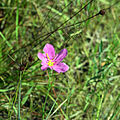| Kissimmee Prairie Preserve State Park | |
|---|---|
IUCN category V (protected landscape/seascape) | |
 Peavine Road | |
| Location | Okeechobee County, Florida, USA |
| Nearest city | Okeechobee, Florida |
| Coordinates | 27°35′35″N81°04′10″W / 27.59306°N 81.06944°W |
| Governing body | Florida Department of Environmental Protection |
| Website | Official website |
Kissimmee Prairie Preserve State Park is a Florida state park, located approximately 25 miles north of Okeechobee, off US 441. [1] [2]














